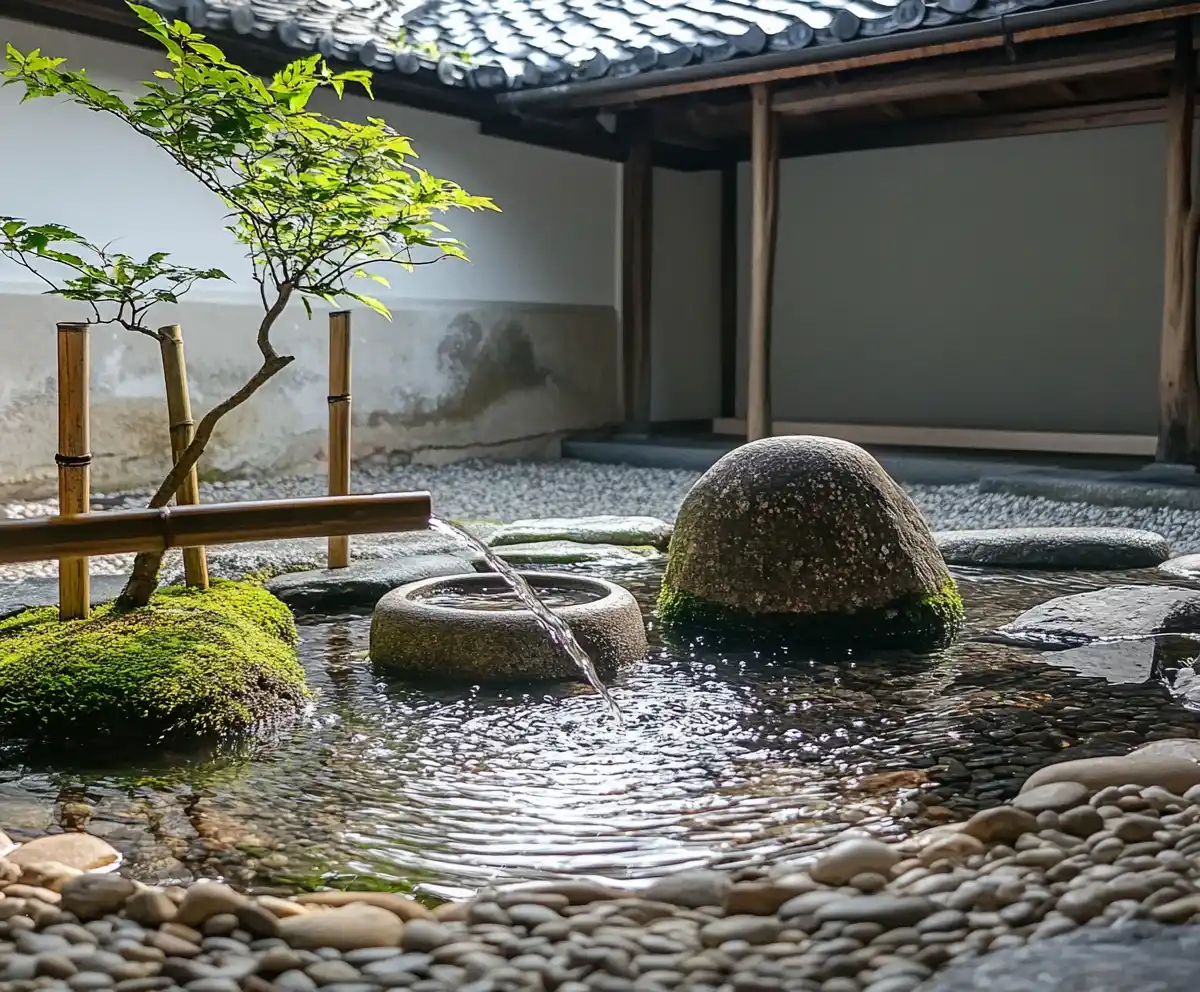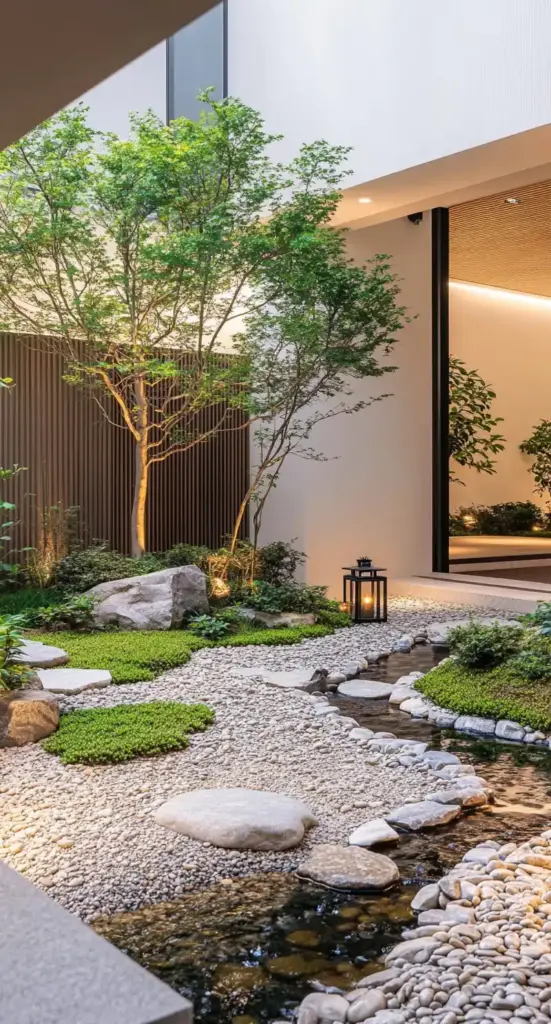Japanese garden design is more than a visual style—it’s a soulful approach to creating peace, harmony, and natural elegance in your outdoor space. Whether you’re designing a cozy small yard or a spacious garden retreat, Japanese garden design invites serenity through timeless principles rooted in nature. These sacred landscapes, influenced by Shinto, Buddhist, and Taoist philosophies, emphasize imperfection, simplicity, and a deep spiritual connection to the earth.
At the core of authentic Japanese garden design is the concept of wabi-sabi—a reverence for the aged, imperfect, and fleeting. This philosophy is expressed through moss-covered lanterns, irregular stone paths, and weathered textures that make every garden feel personal and alive. Rather than ornamental excess, this design style thrives on subtle symbolism—where a single rock might embody a mountain, or raked gravel flows like a dry stream, much like the Zen-inspired patterns found in Kyoto.
Unlike Western-style flower beds, which often aim for symmetry and bright color palettes, Japanese garden design celebrates natural textures, layered planting, and tranquil water features. With thoughtful planning, your garden becomes more than a visual escape—it becomes a story of stillness and personal growth. By embracing Japanese garden design, you’re not just planting greenery—you’re creating a living work of art, one that speaks in silence and grows more meaningful with time.
🌿 Love gardening inspiration? Follow me on Pinterest for bold plant ideas, tips, and seasonal color!
Table of Contents
🌿 Key Design Concepts in Japanese Garden Design
At the core of Japanese garden design are principles that guide not only the layout but also the emotional resonance of the space. These gardens aren’t about ornamental excess—they are minimalist, symbolic, and deeply intentional. Let’s explore some foundational concepts that bring these serene landscapes to life.
Natural Asymmetry: The Art of Imperfect Balance
Nature is rarely symmetrical, and Japanese gardens mirror this truth. You won’t find mirrored flower beds or evenly spaced trees here. Instead, you’ll see rocks of differing sizes, paths that gently curve, and plants that seem to grow freely yet thoughtfully. This approach, known as fukinsei (asymmetrical balance), creates visual interest and encourages the viewer to slow down and appreciate the subtle details.
Symbolism in Every Element
Japanese gardens are layered with meaning:
- Stones may symbolize mountains or islands.
- Raked gravel mimics the ripple of water or the flow of a river.
- Bridges often signify transitions in life or spiritual journeys.
Even the number and placement of rocks follow cultural symbolism—triads representing heaven, earth, and humanity are especially common. These visual metaphors create a space that speaks quietly, yet profoundly, to the soul.
Shizen: Harmony with the Local Landscape
Rather than imposing a garden onto the land, Japanese garden design emphasizes shizen, or naturalness. This means working with your yard’s existing conditions—sunlight, slope, soil, and native plant species. Instead of importing exotic plants, use local flora to blur the boundary between your garden and the natural environment beyond.
For instance:
- In coastal regions, grasses and driftwood may replace more traditional materials.
- In forested areas, ferns, mosses, and pines can create a woodland oasis that still feels authentically Japanese.
Integration of the Senses
Japanese gardens engage more than just the eyes. The crunch of gravel underfoot, the sound of water trickling from a bamboo fountain, and the cool texture of stone all contribute to an immersive experience. These sensory elements deepen the garden’s meditative impact and make it feel alive in every season.
🗺 Garden Layout Planning: Designing with Intention
Thoughtful planning is essential to successful Japanese garden design. Before placing a single stone or plant, take time to study your outdoor space. The goal is not just to fill it, but to create a seamless, flowing environment that aligns with both nature and human use.
Step 1: Observe Your Space
Spend a few days simply watching your yard—notice where the sun rises and sets, where shadows fall, how rain drains, and which areas feel naturally peaceful or exposed. These observations are the foundation of a garden that feels “placed,” not imposed.
- Track sunlight and shade to plan for plant placement.
- Note water flow to guide pond or stream locations.
- Identify existing natural features like trees or boulders that could be integrated.
Step 2: Divide into Functional Zones
Japanese gardens often feature three key zones that together create a balanced outdoor experience:
- Active Zone: This might include a tea pavilion, a seating area, or a small deck—spaces for light activity or socializing.
- Transitional Zone: A meandering path bordered by plants or stones, connecting the outer world to the inner sanctuary.
- Contemplative Zone: A secluded area with a stone bench, gravel garden, or basin—designed purely for quiet reflection.
Each zone should flow naturally into the next, with no hard boundaries.
Step 3: Curved Paths and Stepping Stones (Tobi-Ishi)
Paths in Japanese gardens are never straight. They are designed to slow you down, encouraging mindfulness with every step.
- Tobi-ishi (stepping stones): Irregular in shape and spacing, these guide the feet gently and irregularly.
- Nobedan (flat stone slabs): Used for more formal paths, often near seating or structures.
- Yatsuhashi (zigzag bridges): Typically placed over water, symbolizing life’s unpredictable journey.
Pro Tip: Avoid using modern pavers or overly uniform materials. Natural stone with varied textures and colors blends best.
Step 4: Water as a Central Element
Water—real or symbolic—is a must in Japanese garden design. Its presence symbolizes life, clarity, and renewal.
- Ponds: Include koi and aquatic plants like lotus or iris.
- Streams: Wind naturally through the landscape with local rocks for edging.
- Dry “Rivers”: Use raked gravel to simulate flowing water, especially effective in smaller yards.
Step 5: Layer Plants Like a Natural Forest
Japanese gardens emulate forest ecosystems by layering plants in three vertical tiers:
- Canopy: Japanese maple, pine, or cherry trees.
- Mid-layer: Bamboo, azaleas, or hydrangeas.
- Ground cover: Moss, mondo grass, or creeping thyme.
This layered effect adds depth and mirrors the gentle wildness of nature.
💡 Expert Tip: Use the 70/30 rule—70% evergreen plants for structure and stability, 30% seasonal varieties for color and change.
🏡 Small-Space Design Tips: Serenity in Compact Settings
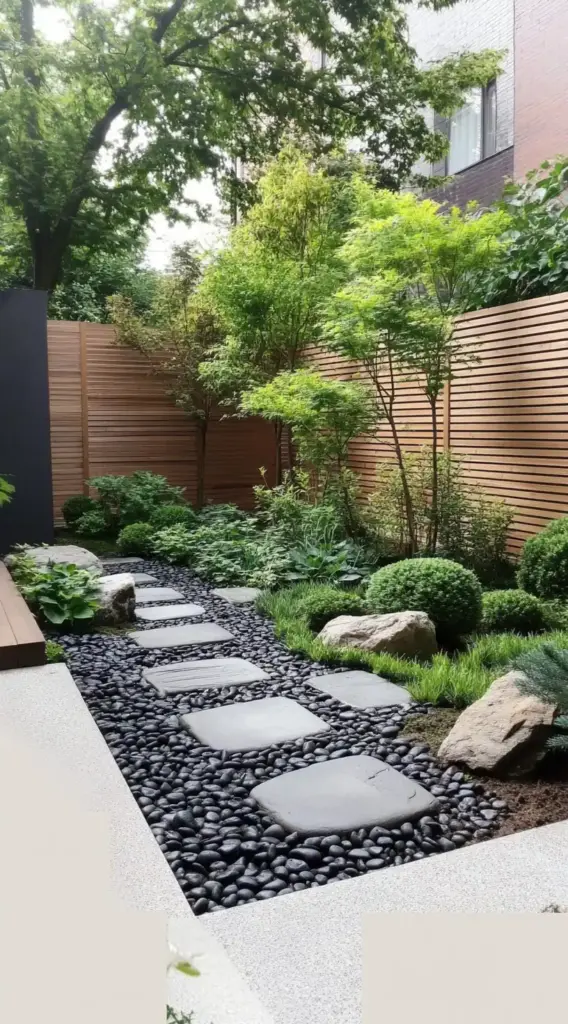
You don’t need a sprawling estate to enjoy the beauty of Japanese garden design. In fact, small backyards, patios, and even balconies can be transformed into peaceful retreats by focusing on minimalism, vertical layering, and creative illusions. Japanese aesthetics thrive in compact spaces by distilling nature into its purest, most symbolic forms.
Vertical Gardens: Bring the Garden Upward
When ground space is limited, think vertically. Walls and fences become prime real estate for greenery.
- Living walls: Use trellises or lattices to support climbing plants like clematis, akebia (chocolate vine), or hydrangea vine.
- Mounted moss panels: Attach weathered wood or reclaimed panels and cultivate moisture-loving moss (Hypnum or Sheet moss).
- Hanging elements: Bonsai, small lanterns, or wind chimes suspended from beams add elevation and elegance.
This layered approach draws the eye upward and creates the illusion of a larger garden space.
Optical Illusions: Expand with Design Tricks
Clever use of depth and perspective can make a tiny garden feel twice as big.
- Mirrors: Subtly placed behind bamboo screens or plants, they reflect light and greenery without revealing themselves directly.
- Forced perspective: Place larger stones or plants at the front of a path, and smaller ones toward the back to stretch perceived space.
- Curved paths: Let stepping stones disappear behind shrubs or garden panels—this suggests hidden space beyond, encouraging exploration.
Compact Water Features: Small Scale, Big Impact
Water is integral to Japanese garden design, and even the smallest gardens can benefit from its calming presence.
- Tabletop Tsukubai: Use a shallow stone basin with a bamboo spout (kakei) to create a small ritual hand-washing station.
- Wall-mounted trickle features: Thin streams of water flowing into a gravel basin can provide soothing sound in just a 2-foot space.
- Reflective dishes: Shallow ceramic bowls with a floating leaf or lily emulate a pond and add visual stillness.
Best Plants for Small Japanese Gardens
Choose plants that offer interest across seasons but don’t overwhelm:
- Dwarf Conifers: Such as Pinus densiflora ‘Umbraculifera’ (Tanyosho pine), which forms an elegant, slow-growing canopy.
- Moss Alternatives: In drier climates, consider Dymondia margaretae or blue star creeper for low-maintenance greenery.
- Grasses and Groundcovers: Hakonechloa macra (Japanese forest grass) softens edges with graceful movement.
🌿 Case in Point: A 10×12-foot Brooklyn patio was turned into a Japanese garden using vertical cedar screens, a 3-foot-wide raked gravel stream, and a single maple tree in a sculptural pot—proof that tranquility thrives in tight quarters.
🧱 Key Garden Features to Include in Japanese Garden Design

A Japanese garden is built not only with plants and pathways but also with iconic features that ground the space in tradition and symbolism. Each element contributes both aesthetically and philosophically, creating a harmonious and immersive experience.
Here are the must-have features that define an authentic Japanese garden design:
Stone Lanterns (Tōrō)
These sculptural lights aren’t just decorative—they symbolize illumination, guidance, and the connection between the earthly and the spiritual.
- Traditionally used to light the path to tea houses.
- Soft, diffused shadows create a sense of mystery and calm.
- Available in granite, basalt, or even concrete for a modern twist.
Place them near transitions: at the edge of a path, beside a water feature, or marking the entrance to a contemplative zone.
Bamboo Fences (Takegaki)
Privacy meets artistry with traditional bamboo fencing. These aren’t meant to block views entirely, but rather to frame scenes and create a sense of enclosure.
- Takegaki: Interwoven vertical and horizontal poles, often tied with black cord.
- Yarai: Simple vertical poles for boundaries or backdrops.
- Use to hide compost bins, HVAC units, or neighboring structures without losing the garden’s organic feel.
Pro Tip: Soak bamboo in water for flexibility, and treat it with natural oils to preserve color and prevent cracking.
Tsukubai: Ritual Stone Basins
A tsukubai invites ritual and mindfulness. Traditionally used for washing hands before a tea ceremony, this feature encourages visitors to pause and reflect.
- Made from carved stone, often paired with a bamboo spout (kakei).
- Works beautifully in both large gardens and small courtyard spaces.
- Add a small submersible pump for a quiet, recirculating water flow.
Pair it with ferns or moss for an authentic, aged appearance.
Karesansui: Zen Gravel Gardens
Also known as dry landscape gardens, these areas offer a minimalist expression of nature through rock and gravel.
- Raked patterns represent waves, ripples, or flowing rivers.
- Stones symbolize islands, mountains, or animals.
- Ideal for meditation corners or low-maintenance focal points.
Design with odd numbers of stones, and vary their sizes and shapes to avoid artificial symmetry.
Pruned Trees and Moss Carpets
A well-pruned pine tree can become the living sculpture of your garden, embodying strength, endurance, and seasonal beauty.
- Use cloud pruning to shape pine or juniper.
- Let moss fill the spaces between stones and path edges to evoke age and tranquility.
- In dry regions, try moss alternatives like Irish moss or creeping thyme for similar texture with lower water needs.
🏯 Japanese Garden Styles & Inspiration
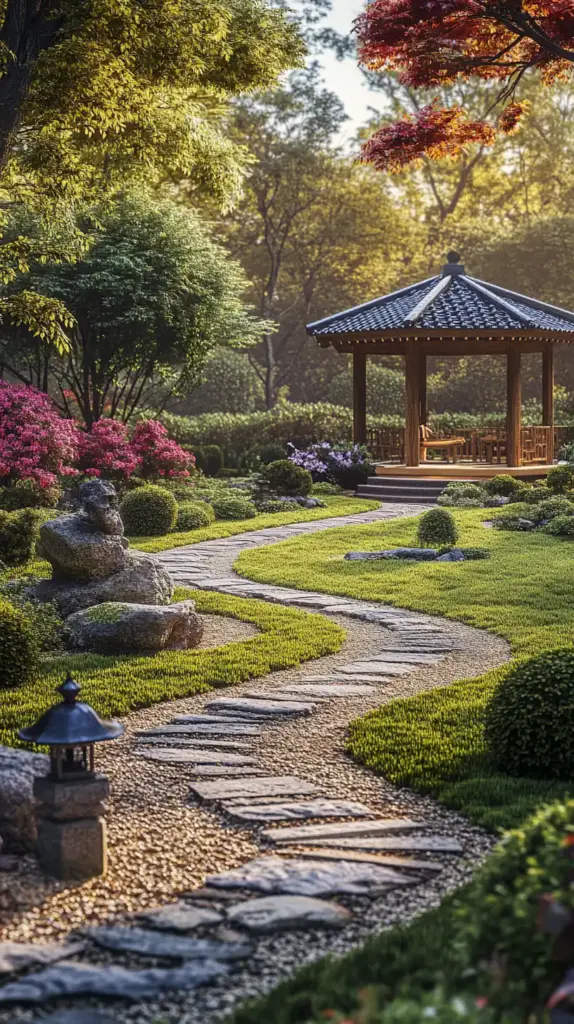
One of the most beautiful aspects of Japanese garden design is its flexibility. While rooted in centuries of tradition, these gardens offer a variety of styles to match different spaces, personalities, and lifestyles. From tranquil tea gardens to dramatic Zen landscapes, here are the most iconic styles to inspire your own creation.
1. Tea Gardens (Chaniwa)
Originally created for the tea ceremony (chanoyu), tea gardens foster introspection and ritual.
Key Features:
- Roji (dewy path): A stepping stone path symbolizing a journey from the outer world to inner calm.
- Tsukubai: A low stone basin with a bamboo ladle, used to purify hands before entering the tea space.
- Plant Palette: Evergreen plants like camellia and pine, with seasonal touches like maple leaves or blooming sasa bamboo.
Modern Adaptation: Swap the traditional tea house for a shaded bench or minimalist cedar pavilion. Reclaimed materials can maintain an authentic feel while reducing costs.
2. Stroll Gardens (Kaiyū-shiki-teien)
These large, walkable gardens are designed to reveal scenes in stages, creating moments of discovery at every turn.
Layout Principles:
- Circular Paths: Meandering trails that loop around a central pond or feature.
- Seasonal Vistas: Use cherry trees (sakura) in spring, hydrangeas (ajisai) in summer, and maples (momiji) in autumn for year-round interest.
- Focal Points: Bridges, waterfalls, lanterns, and moon-viewing decks placed at visual pauses.
Inspiration: The Portland Japanese Garden’s Stroll Garden captures this style brilliantly, integrating elevation changes and Pacific Northwest flora for a seamless fusion.
3. Courtyard Gardens (Tsubo-niwa)

Perfect for tight urban settings, tsubo-niwa use every square foot with purpose. Despite their compact size, they offer a rich sensory experience.
Core Elements:
- Vertical Planting: Bamboo screens with ferns or trailing shiso (perilla).
- Sound & Movement: A small shishi-odoshi (bamboo deer-scarer) creates ambient water sounds.
- Multi-use Stones: Stones double as seats, steps, or displays for potted bonsai.
Pro Tip: Frame views from interior windows to make the garden feel like an extension of your living space.
4. Zen Meditation Gardens (Karesansui)
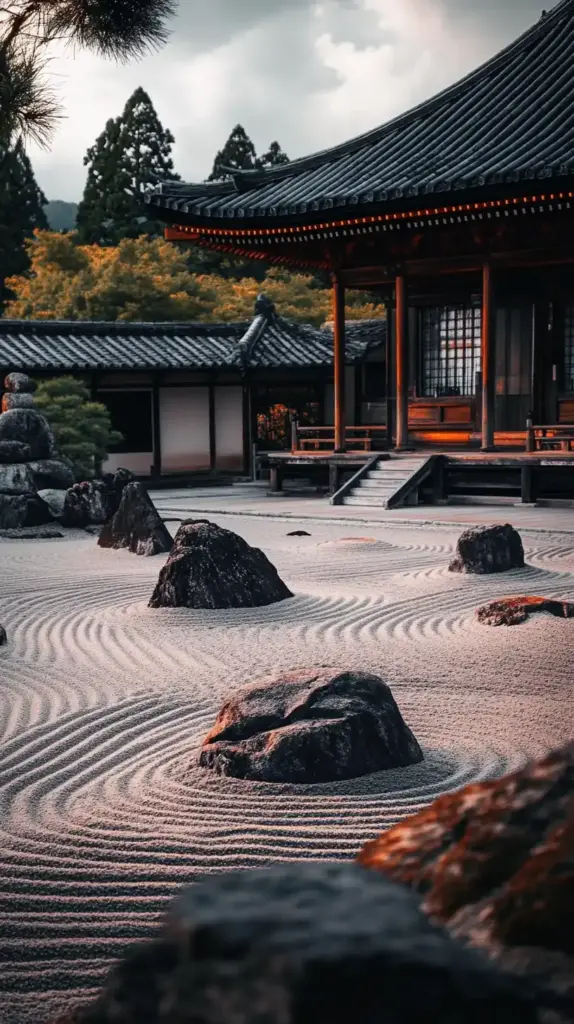
Minimalist and abstract, these dry gardens use symbolism and texture to invite stillness and contemplation.
Design Techniques:
- Gravel Raking: Use straight lines for calm or swirls for dynamic energy.
- Rock Placement: Odd-numbered groupings avoid artificial balance and mimic nature’s randomness.
- Borrowed Scenery (Shakkei): Frame distant trees, rooftops, or hills to “extend” the garden visually.
Low Maintenance Tip: Dark lava rocks contrast beautifully with pale gravel and require less upkeep than traditional white sand.
5. Modern Fusion Gardens
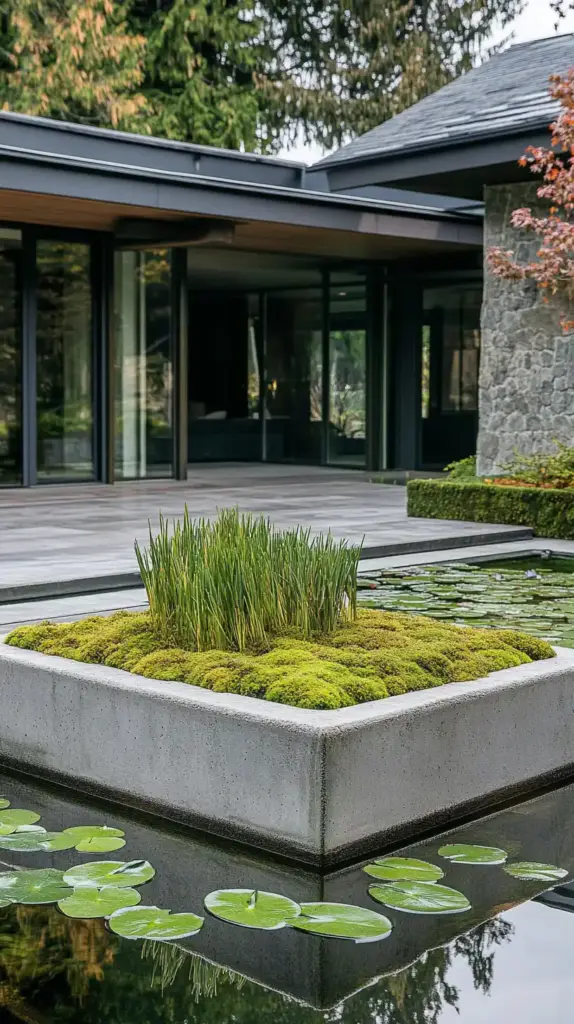
For those who appreciate tradition but want to add a contemporary edge, Modern Fusion gardens blend the best of both worlds.
Contemporary Ideas:
- Concrete & Moss: Use sleek geometric planters softened by creeping moss.
- Steel Water Troughs: Replace ponds with rusted corten steel basins filled with floating lily pads.
- LED Lighting: Subtle pathway lighting or under-bench glow enhances nighttime tranquility without clashing with nature.
✨ These styles are not rigid blueprints but inspirational templates. Feel free to mix elements that resonate with your space, values, and creativity.
🧰 DIY Tips and Tutorials: Craft Your Own Japanese Garden
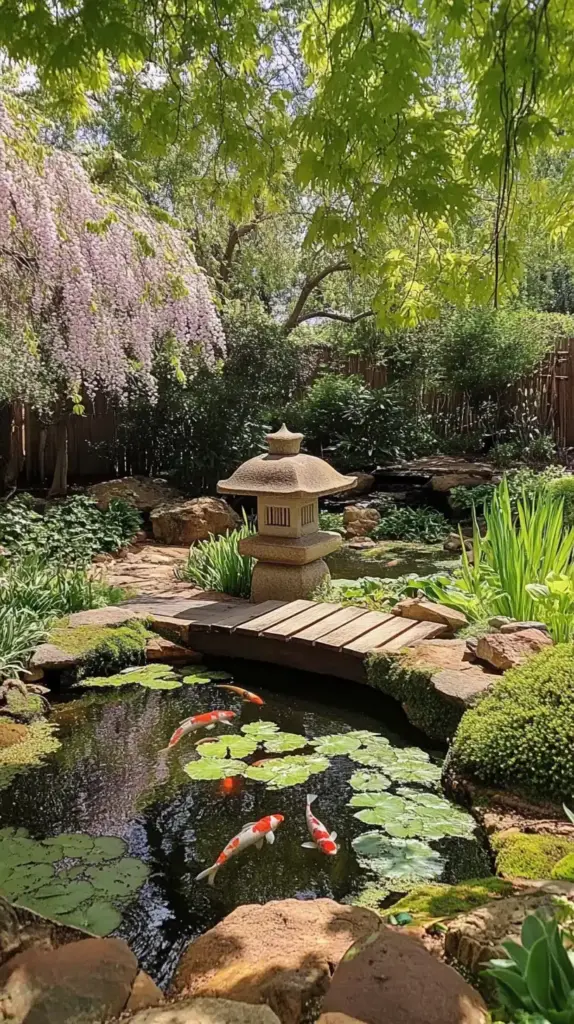
One of the most rewarding aspects of Japanese garden design is how accessible it can be, even for DIY enthusiasts. Whether you’re starting from scratch or enhancing an existing garden, these step-by-step tips will help you bring traditional elements to life in a thoughtful, cost-effective way.
Step 1: Choosing the Right Plants
Selecting the right plant palette is key to achieving authenticity, longevity, and ease of care.
Regional Substitutes:
- Cold climates: Try Amur maple (Acer ginnala) instead of cherry blossoms.
- Dry regions: Use Nandina domestica (heavenly bamboo) as a drought-resistant alternative to real bamboo.
Starter Plant Suggestions:
- Shade-lovers: Hostas, Japanese painted fern.
- Sun-lovers: Hakonechloa macra (Japanese forest grass), Iris ensata (Japanese water iris).
🌱 Pro Tip: Shop at native plant nurseries—they’ll offer species suited to your local environment, reducing maintenance and increasing success.
Step 2: Building a Dry Landscape (Karesansui)
Create a minimalist Zen area that emphasizes form, texture, and meditation.
Materials Needed:
- Coarse sand or crushed granite (2–3 inches deep)
- 3–5 weathered rocks (basalt or limestone)
- Landscape fabric, optional metal edging
Steps:
- Outline your dry garden area using a garden hose.
- Install edging (optional) for cleaner lines.
- Lay fabric to suppress weeds.
- Add gravel, then place stones using a triangular formation.
- Rake the surface into lines or spirals using a wide-toothed bamboo rake.
🔄 Maintenance Tip: Refresh gravel annually and lightly rake patterns weekly to maintain visual clarity.
Step 3: Installing a Bamboo Fence (Takegaki)
Create elegant screens that frame your garden and provide a sense of enclosure.
Materials:
- Bamboo poles (1–2″ diameter)
- 4×4 wooden posts
- Copper wire or black twine
- Quick-setting concrete
Instructions:
- Soak bamboo for 48 hours for flexibility.
- Set vertical posts in concrete, spaced 6 feet apart.
- Weave or tie bamboo poles horizontally using copper wire.
- Seal bamboo with linseed oil to protect against the elements.
🛠 Cost Estimate: A 10-foot section can be installed for around $100 with DIY effort.
Step 4: Crafting a Stepping Stone Path
Paths guide visitors while reinforcing mindfulness and flow.
Materials:
- Irregular flagstones
- Gravel and sand
- Moss or creeping groundcovers
Installation:
- Lay out stones on the ground to visualize spacing.
- Dig 2–3 inches into the soil for each stone.
- Set stones in sand for leveling.
- Fill gaps with gravel or plant moss for a natural finish.
🪨 Pro Tip: Space stones unevenly to slow down walking pace—this deepens the sensory experience of the garden.
Step 5: Building a Mini Koi Pond
You don’t need a large yard for a peaceful pond. A compact version brings sound, movement, and wildlife into your garden.
Materials & Setup:
- Preformed polyethylene pond (50–100 gallons)
- Submersible pump and filter
- Flat edging stones
- Aquatic plants (e.g., water lilies)
- 2–3 small koi or goldfish
Installation:
- Dig and level the hole to fit the pond liner.
- Place and secure the liner with edging stones.
- Install pump/filter and fill the pond.
- Add fish and aquatic plants.
💧 Cost Estimate: Around $300 for a 75-gallon setup with fish and filtration.
🌍 Real-Life Examples: Inspiration from Around the World
Nothing illustrates the timelessness and adaptability of Japanese garden design better than real-life examples. From revered temples in Kyoto to small suburban yards in California, these gardens embody serenity, symbolism, and local adaptation. Use these case studies to spark your own creativity—no matter where you live.
Iconic Japanese Gardens Around the World
Ryoan-ji Temple (Kyoto, Japan)
- Highlight: The ultimate Zen dry landscape with 15 rocks carefully arranged on raked gravel.
- Why It Works: You can only see 14 stones from any one angle, a symbolic reminder of life’s mysteries and imperfections.
- Design Lesson: Minimalism can be deeply meaningful. Less truly is more.
Kenroku-en (Kanazawa, Japan)
- Highlight: One of Japan’s “Three Great Gardens,” combining spaciousness, serenity, antiquity, and seasonal beauty.
- Why It Works: Every season offers something new—snow-covered pines in winter, cherry blossoms in spring.
- Design Lesson: Design for year-round interest by mixing evergreens with seasonal showstoppers.
Portland Japanese Garden (Oregon, USA)
- Highlight: Fuses Japanese principles with Pacific Northwest native plants and basalt features.
- Why It Works: It honors tradition while reflecting local ecology.
- Design Lesson: Use regional materials and plants to maintain harmony with your environment (shizen).
Adachi Museum Garden (Shimane, Japan)
- Highlight: Integrates distant landscapes (borrowed scenery or shakkei) into the garden’s composition.
- Why It Works: Creates the illusion of infinite space and scale.
- Design Lesson: Use windows, frames, or strategic planting to extend your garden visually.
Homeowner Case Studies
Urban Rooftop Retreat – Tokyo, Japan
- Challenge: Limited space (200 sq ft), harsh winds, and weight restrictions.
- Solution:
- Lightweight aluminum trellises for vertical vine growth.
- A faux dry streambed made from painted concrete and edged with mondo grass.
- A stainless-steel tsukubai with a solar-powered recirculating pump.
- Result: A calming, low-maintenance escape above the city, blending traditional features with modern resilience.
Suburban Transformation – California, USA
- Challenge: 1,500-square-foot yard overtaken by ivy and uneven terrain.
- Solution:
- Terracing with salvaged sandstone to build elevation and depth.
- Installation of a koi pond using a preformed liner.
- A drought-tolerant plant palette blending Japanese maples with California-native grasses.
- Result: A balanced garden that honors Japanese aesthetics while respecting the regional climate and ecology.
🧭 Takeaway: Your Japanese garden doesn’t have to be in Japan—it simply needs intention, symbolism, and respect for its surroundings.
🛠 Maintenance Tips: Caring for Your Japanese Garden
A well-designed Japanese garden is not static—it evolves gently with the seasons and deepens its character over time. Regular care ensures the space remains both beautiful and meaningful. Maintenance is not a chore but a mindful ritual that strengthens your connection to the garden.
🌸 Seasonal Maintenance Guide
Spring
- Pruning: Trim back azaleas, pines, and maples after the last frost using soft, angled “nibble cuts” to retain their natural shape.
- Moss Care: Sweep away debris with a soft broom and spray buttermilk solution on bare patches to stimulate moss growth.
- Water Features: Clean filters, top off basins, and introduce barley straw bundles to reduce algae naturally.
Summer
- Watering: Water early in the morning to reduce evaporation; drip irrigation works well for ferns and moss.
- Pest Control: Handpick aphids from foliage. Use neem oil sparingly for stubborn infestations.
- Gravel Gardens: Rake patterns weekly to maintain their symbolic clarity and reduce weed growth.
Autumn
- Leaf Cleanup: Net ponds to prevent clogging from falling leaves. Shred and mulch excess leaves into planting beds.
- Structural Edits: This is a great time to reposition stones or expand paths, as plants recede and space opens up.
Winter
- Protection: Wrap delicate trees like Japanese maples in burlap if frost is expected.
- Snow Removal: Brush heavy snow off bamboo fencing and stone lanterns to prevent cracking or structural damage.
- Tool Prep: Sharpen pruning shears, oil wooden rakes, and organize your supplies for spring readiness.
🧪 Troubleshooting Common Issues
Algae in Ponds
- Fix: Add floating plants (e.g., water lettuce, lilies) to shade water. Consider a UV clarifier for stubborn blooms.
Moss Browning
- Fix: Test soil pH (ideal: 5.5–6.0). Mist with rainwater instead of tap if water is too alkaline.
Bamboo Splitting
- Fix: Seal ends with clear wood glue and lightly sand rough edges. Replace cracked poles in early spring before new growth begins.
🧘♀️ Mindful Upkeep Practices
Daily Rituals
- Spend 10–15 minutes each day inspecting plants, raking gravel, or simply sitting with the space. These quiet moments enhance the meditative spirit of Japanese garden design.
Intentional Repairs
- Don’t rush to hide flaws—highlight them. A chipped lantern covered in moss or a leaning stone can embody wabi-sabi—the beauty of imperfection.
Garden Journal
- Record changes, seasonal blooms, and wildlife sightings. Over time, your notes will become a personal history of the garden’s growth.
🌱 Involve family or friends in simple tasks like feeding koi or raking gravel. These shared moments turn maintenance into a tradition.
🌸 Conclusion: A Living Work of Art
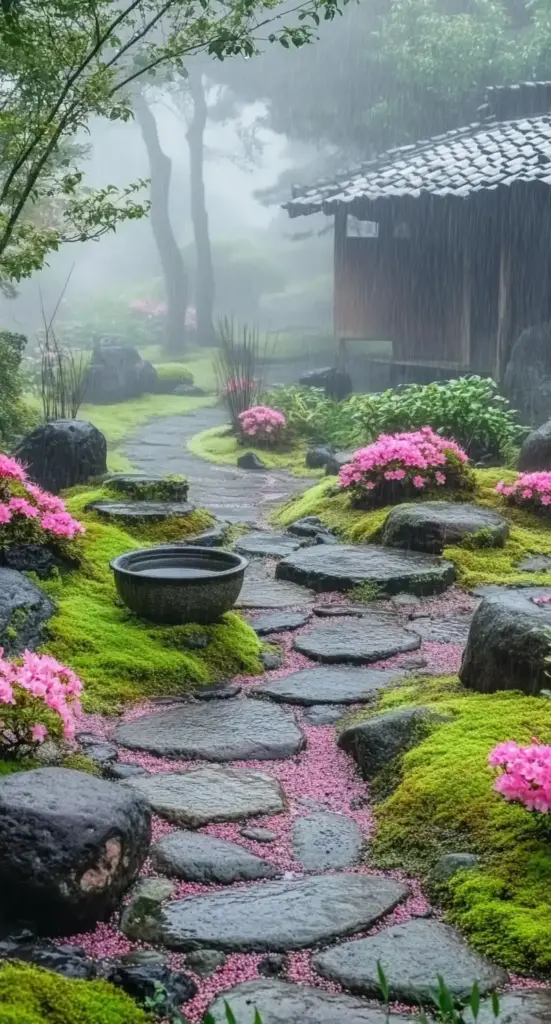
A Japanese garden design is never truly finished—it’s a living expression that breathes, evolves, and deepens over time, much like the people who care for it. The moment you place your first stone or rake a swirl into a dry gravel bed, you enter into a silent, ongoing conversation with nature, tradition, and inner peace.
Don’t rush to create everything at once. Begin with something simple—a small bonsai, a shallow water dish, or even a DIY trellis to support a climbing plant. These modest touches can anchor your Japanese garden design and blossom into something deeply personal. With each season, your garden becomes a mirror of your journey—marked by growth, change, and reflection.
By embracing traditional philosophies and incorporating modern materials or small-space strategies, your Japanese garden design can become a sanctuary that nurtures both your home and your spirit. Whether it’s a compact Zen nook or a full backyard transformation, this style brings enduring calm to any landscape.
Your garden is more than a layout—it’s a quiet philosophy come to life, and with every mindful detail, Japanese garden design turns your yard into a truly sacred space.

